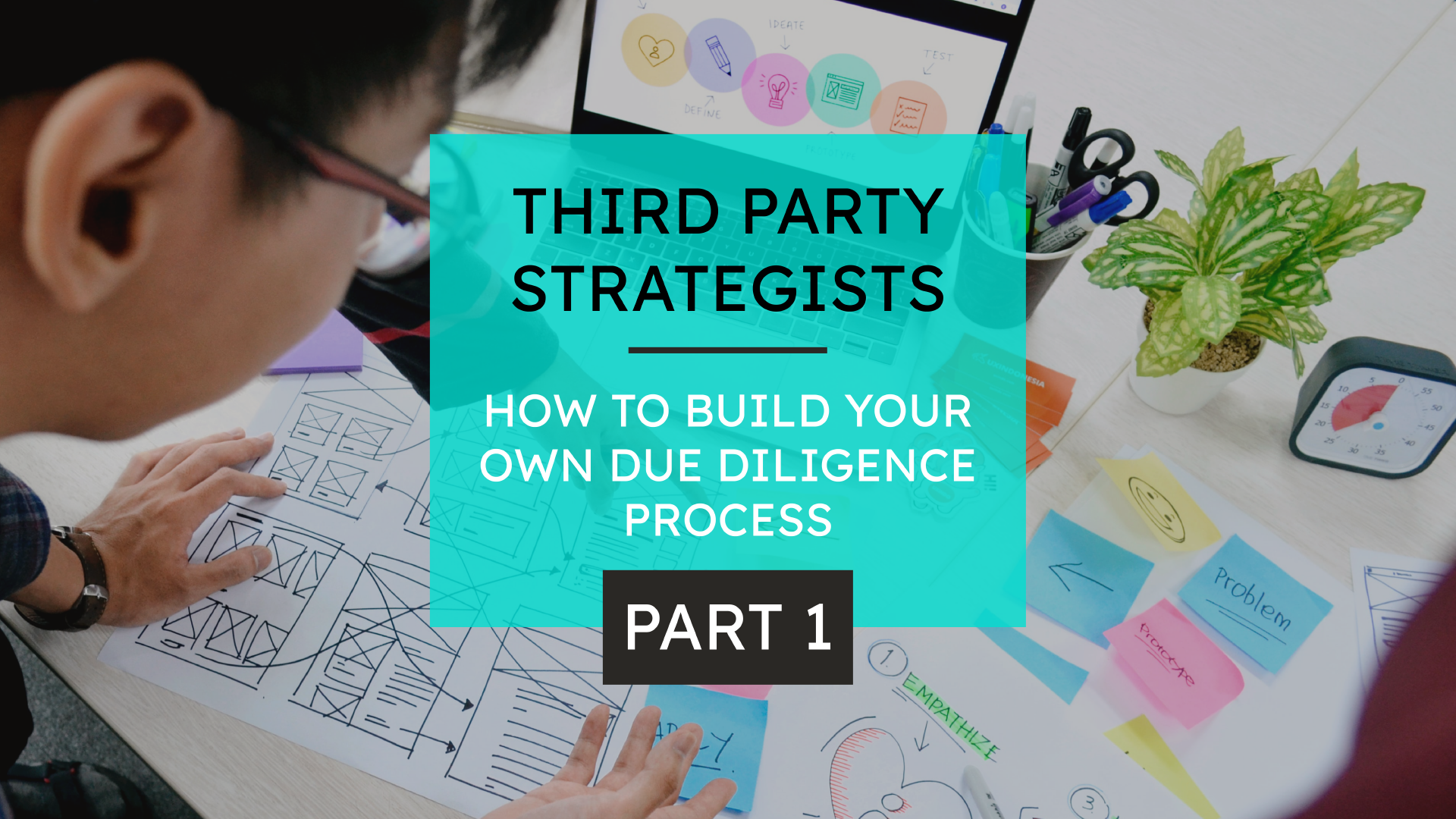
As we move into an environment where more and more advisors are outsourcing portfolio management, it is critical that you have a way to evaluate each provider before you jump into an engagement with them.
So, how do you decide which providers will be best for both yourself and your clients?
Whether due to time constraints or lack of understanding, we have found that many advisors haven’t been taught a due diligence strategy. They choose a few items in a performance filter, see who rises to the top, play a little bit of “eenie, meenie, miney, mo” and see how it goes.
But this can get you into a lot of trouble if you don’t understand:
- Firm Structure
- Communication Expectations
- Program Design
- Returns
You can put yourself in some very compromising situations with your clients, if you don’t have a clear understanding of these four fundamentals up front.
So, whether you adopt our process, or take a few key points away from it to design your own, we hope that our Firm CPR Due Diligence Process can help you make the best decision about third-party strategists in the future.
What is Firm CPR?
My guess is that most people have not heard of expectational investing (unless you’ve listened to our podcast). Expectational investing is not about returns, it’s not about performance reports, it’s about understanding what’s happening when it happens and deciding whether it meets your expectations.
We use expectational investing as the basis for our Firm CPR process as we find it best highlights what each manager says they are doing, how they are doing it, and what the expected return from those first two elements should be.
Do the returns confirm or deny the expectation?
This Firm CPR process consists of four parts: Firm Structure, Communication, Program Design, and Returns. They are not listed in this order arbitrarily, but rather very purposefully. After you understand the first, the second can come into clearer view and so forth. The more you know from the beginning, the better off you are.
1) Firm Structure
There are several different firm structures from which to choose when it comes to a portfolio manager. You’ll want to know if the firm is independently owned or part of a larger entity. This will enable you to determine if their structure allows you to communicate with the managers themselves, or if will you be connecting with a representative when you have questions.

Understanding how the structure works, how the manager is organized, and how they distribute information will reveal a good deal about whether they’ll be a good fit for you.
Of course, no one model is inherently “good or bad.” It’s about how you prefer your relationship with your PM to be structured. If their model complementary to your advisory style, fantastic. If not, scratch them off the list and keep working.
Your clients are trusting you to know and understand the ins and outs of their portfolio. If it is difficult to get in touch with someone at the firm about what’s happening, you may want to consider firms with a different structure.
2) Communication
Communication is really a deeper dive into the firm structure point. How the manager communicates reflects how you will be able to update your clients informed and educated along the way. Timely commentaries are something our Potomac clients have really valued over the past ten years. The style, frequency, and mode of communication you can expect from your manager will dictate your own client communication.
Again, one model is not necessarily better or worse than another. It goes without saying that sufficiency will be of paramount importance, but beyond that, the mode and frequency will really be a personal preference. You don’t want to get caught scratching your head by a client, unable to answer why the portfolio did x, y, and z. This is not a good look (and probably a surefire way to put yourself in hot water with your client)!
Wait! There is another side to this communication coin. Not only do you need to find out how the firm will reach out to you, but what will happen when you reach out to them. How will your communication be received and handled? Some platforms allow you to speak directly with a manager while others hold you at an arm’s length, collect their basis points for doing the trades, and are not open to answering a multitude of questions. If you aren’t getting enough information automatically, and there isn’t anyone willing to answer your questions when they arise, you’ll be left with nothing to tell your clients. The point is we want to see advisors doing their due diligence before they get caught in a compromising situation.
3) Program Design
Program Design is comprised of two parts:
- Who does your manager say they are?
- How do they do what they do?
Are you considering a management firm that claims to specialize in risk management or growth? If they say they are in risk management, look at their protocol for managing risk. If growth is their focus, explore how aggressive can you expect them to get. You might find that their definition of risk management is just peeling back five or ten percent when volatility reaches a certain measure. The goal is to ensure their protocol satisfies your investment philosophy.
Let us use ourselves as an example, because this one question came up more than any other in 2009. Advisors were asking, “Who uses cash?” Is it five or ten percent? Well, theoretically, in all our portfolios, we could go 100% cash. If you as the advisor didn’t know that, it doesn’t matter what the returns are, because you have no idea what that expectation is. Suddenly, your clients call you because they’ve been in cash for two months, you had no idea, and have no way of explaining it to boot! Again, not a good look!
Understanding what your management firm does and how they do it will eliminate surprises. Ask what securities they are using. Ask if they’re a quant shop. Find out if they’re sending people out to meet with different businesses that they are buying individual stocks from. Channel the curiosity of Dorothy in the Wizard of Oz for a moment and find out what is going on behind the curtain. Once you understand the above, you can then use the returns to validate if they are delivering on what they’re advertising.

4) Returns
Now, you might be wondering why aren’t returns at the top of the list? Simply put, they can’t possibly tell the whole story. They are inarguably important, but they become invaluable when analyzed in the context of Firm Structure, Communication, and Program Design. Returns are used to validate (or nullify) what you have learned.
Looking at the returns in the context of the firm’s advertised mission is simple: perform when they should have. If there anomalies that suggest an error gap between what should have happened and what happened, find out why.
Numbers should back up what a strategist is trying to accomplish. Returns in isolation can’t answer every question. True performance can only be understood in the context of the advertised goal.
The last step in terms of returns is projecting what will happen when you combine investment strategists. What will be the potential outcome if I go with “x” growth manager and “y” risk management manager? Many advisors will turn to risk scoring software which amalgamates the numbers. But this is just an arbitrary combination of scores. This really doesn’t provide any insight on what could happen in a certain type of environment. Just looking at returns isn’t going to give you the answers you need to successfully choose your third-party strategists. This could be a step in your process, but don’t rely on these computer-generated combinations alone to make your final decision.
Locking It In
While we don’t expect this process to be your end-all, be-all when it comes to evaluating an investment strategists, we have been around the block a few times and are confident you can utilize some or all of the Firm CPR steps into your own due diligence process.
(Of course, this is assuming you’ve found a strategist to begin with. More on that in Part 2.)
Our goal here is to simply help advisors become smarter and wiser in choosing their investment strategist before they make egregious errors with wrong-fit firms.
Firm CPR is our process.. What’s yours?
Disclosure: This information is prepared for general information only and should not be considered as individual investment advice nor as a solicitation to buy or offer to sell any securities. This material does not constitute any representation as to the suitability or appropriateness of any investment advisory program or security. Please visit our FULL DISCLOSURE page.
